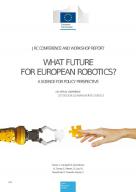Description
Europe is a world-leader in the production of robots. This industry is a key element of the digital transformation of our societies and economies that, combined with Artificial Intelligence (AI), will likely have a tremendous disruptive potential. To explore further the future of the European robotics industry and its related challenges, the Joint Research Centre organized a Science for Policy conference entitled “What future for European Robotics?”, bringing together recognized specialists from industry, academia and policy. This report presents the main conclusions that emerged from the conference.
Key take-away from the conference
The European Commission is coming forward with a broad portfolio of policy initiatives to ensure that no one is left behind, and to set-up an adequate legal framework. Robotics was placed among the main priorities in the review of the Coordinated Plan on Artificial Intelligence, while the horizontal regulation on Artificial Intelligence proposes conditions for the use of high-risk AI applications.
Additionally, the proposal for a Regulation on machinery products – a centrepiece legislation for safety of robots in the EU – enhances requirements for new emerging autonomous robots.
Robotics could also be key for the post-pandemic recovery in the EU, if we make sure to support regional innovation, start-ups, stronger involvement in the public sector, and ensuring a competitive advantage.
Among the recommendations included in the report - which are the results of a three-day series of discussion among leaders in industry, academia and policy-making –the need for robot design and development to comply with human rights is mentioned, as well as to keep humans in command, and to foresee measures against any negative environmental impact.
The advice given to policy-makers is to ensure that ethical technology assessments are carried out before deploying AI/robotics technology, and to consider a regulatory framework to minimise risks for children during social child-robot interaction.
This is already reflected in other Commission’s initiatives like the revision of the Machinery Directive, focusing on various elements like robot safety, human-machine interaction and transparency, or the Product Liability Directive, in which rules for compensation to customers to whom damage has been caused from the use AI and robots will be further clarified.
Watch the main takeaways of the Conference

